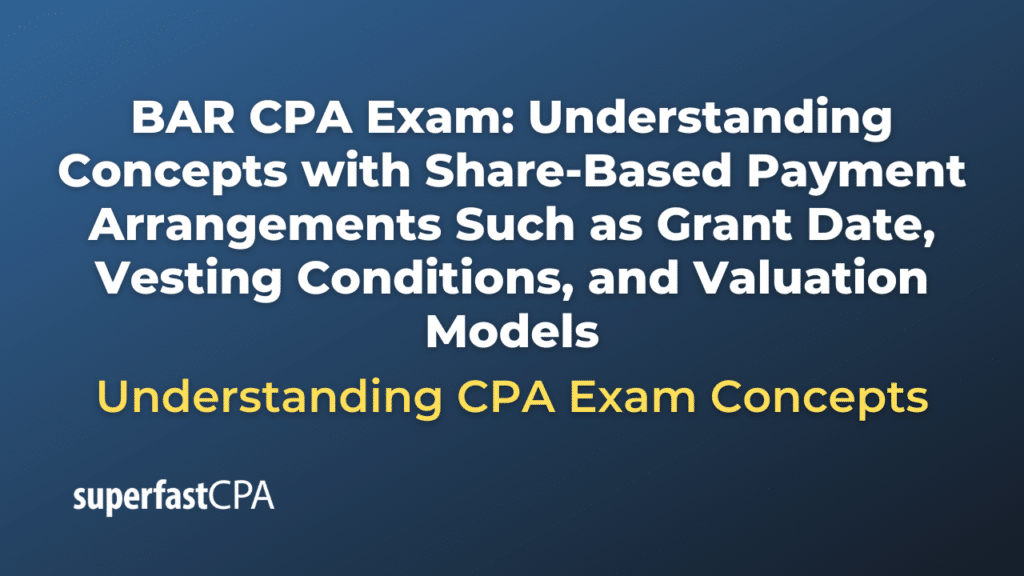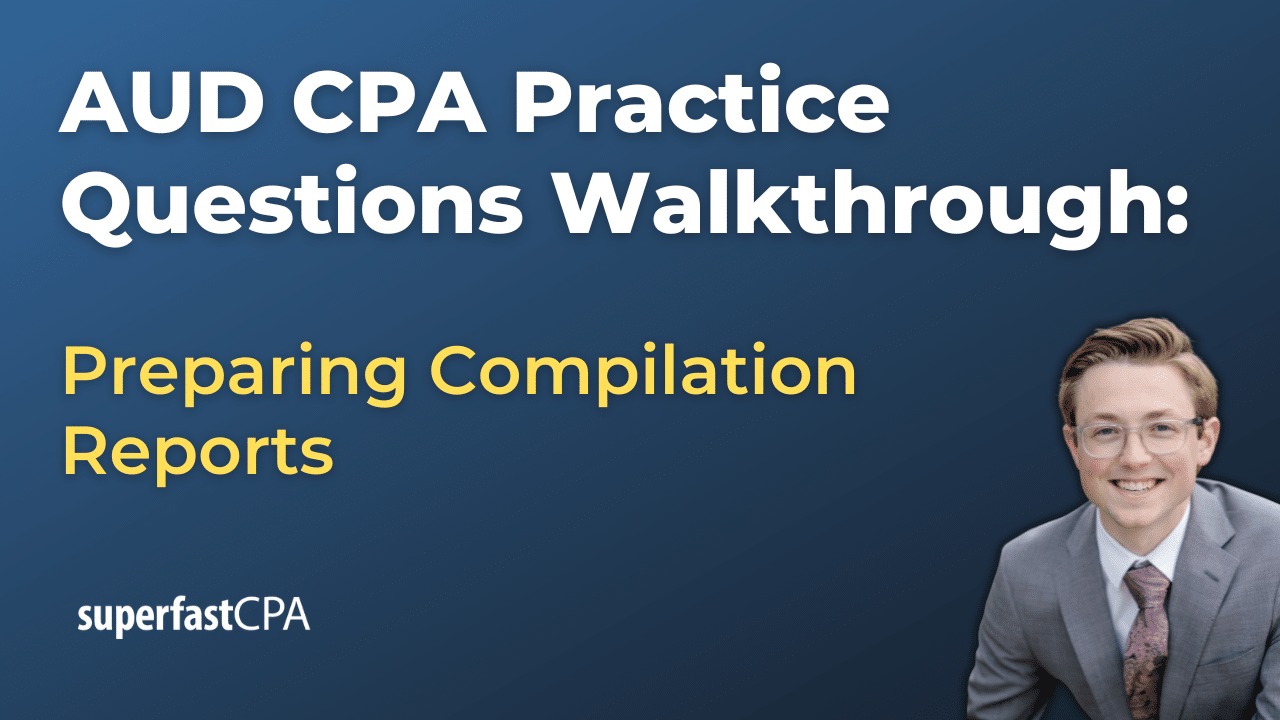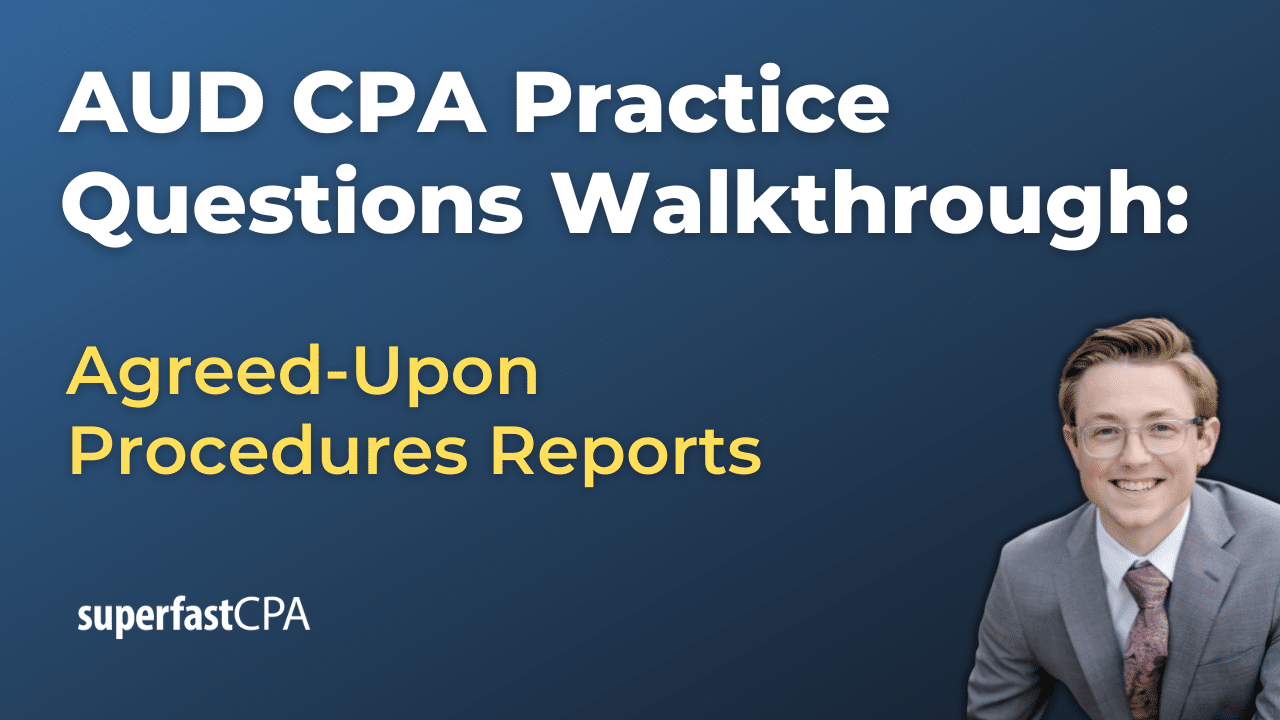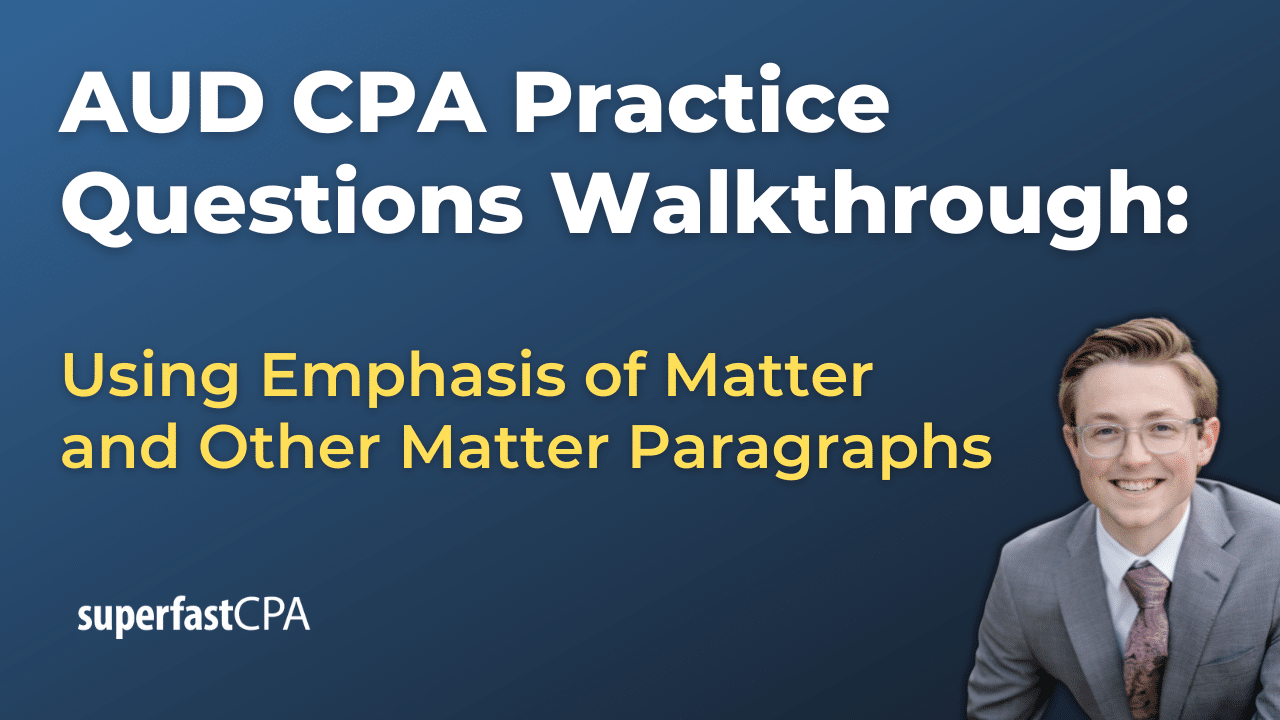Introduction
Purpose of the Article
In this article, we’ll cover understanding concepts with share-based payment arrangements such as grant date, vesting conditions, and valuation models. Understanding the intricacies of share-based payment arrangements is crucial for CPA exam candidates, particularly those preparing for the BAR section. Share-based payments, often in the form of stock options or restricted stock, represent a significant component of employee compensation in many companies, especially within the technology and start-up sectors. These arrangements not only incentivize employees but also align their interests with those of the shareholders.
However, the accounting for these payments is complex and governed by specific standards, such as ASC 718 in the U.S. Generally Accepted Accounting Principles (GAAP). Misinterpretation or improper accounting of share-based payments can lead to material misstatements in financial statements, which underscores the importance of these concepts in financial reporting.
This article aims to demystify the key elements of share-based payment arrangements, focusing on fundamental concepts like the grant date, vesting conditions, and valuation models. These topics are not only essential for accurate financial reporting but are also critical areas of knowledge for candidates preparing for the CPA exam. Mastery of these topics will enable candidates to approach related exam questions with confidence and ensure they have a solid understanding of how these arrangements impact a company’s financial statements.
Overview of Share-Based Payment Arrangements
Definition and Types
Share-based payment arrangements are a form of compensation provided to employees or other parties, wherein they receive equity instruments of the company, such as shares or stock options, as part of their remuneration. These arrangements are designed to align the interests of the employees with those of the shareholders, by linking compensation to the company’s performance and share price.
Types of Share-Based Payments:
- Stock Options: These are the most common form of share-based payments. Employees are granted the right to purchase company stock at a predetermined price, known as the exercise or strike price, after a certain period or upon meeting specific conditions.
- Restricted Stock: This type of share-based payment involves the issuance of company stock to employees, but with certain restrictions, such as a vesting period. The stock cannot be sold or transferred until the restrictions lapse.
- Performance Shares: These are shares granted to employees based on the achievement of specific performance targets, such as reaching a certain level of earnings or stock price. The number of shares awarded can vary depending on the level of performance achieved.
- Stock Appreciation Rights (SARs): These rights provide the holder with a cash payment or shares equivalent to the appreciation in the value of the company’s stock over a specified period.
Each of these types of share-based payments has unique accounting implications, making it crucial for CPA candidates to understand their characteristics and how they impact financial statements.
Relevant Accounting Standards
The accounting for share-based payments is governed by specific accounting standards that provide guidance on the recognition, measurement, and disclosure of these transactions.
In the U.S., the primary standard is ASC 718 (Compensation—Stock Compensation), which is part of the Financial Accounting Standards Board (FASB) Accounting Standards Codification. ASC 718 outlines the rules for recognizing compensation costs associated with share-based payment arrangements in the financial statements. This standard requires that companies measure the cost of equity-based compensation based on the fair value of the equity instruments on the grant date and recognize this cost over the period during which the employees provide services in exchange for the awards.
Globally, IFRS 2 (Share-based Payment) is the equivalent standard under International Financial Reporting Standards (IFRS). While the core principles are similar, there are differences in specific applications and disclosures between IFRS and U.S. GAAP that CPA candidates should be aware of.
Understanding these standards is crucial for ensuring that share-based payments are accounted for accurately, and for passing the CPA exam, where questions related to ASC 718 and share-based payments are commonly tested.
Grant Date
Definition and Importance
The grant date in a share-based payment arrangement is the specific date when the company and the recipient (typically an employee) have a mutual understanding of the terms and conditions of the share-based payment. This is the date on which the employer and the employee agree upon the essential terms of the equity award, including the number of shares or options granted, the exercise price (if applicable), and the vesting conditions.
The grant date is crucial because it establishes the starting point for measuring the fair value of the equity instruments granted. This fair value is then used to calculate the total compensation expense that the company will recognize over the vesting period of the award. The grant date is significant because it locks in the fair value of the share-based payment, which is based on the company’s stock price and other relevant factors on that date.
Accounting Implications
The grant date plays a pivotal role in determining the compensation cost associated with share-based payment arrangements. The accounting rules, as outlined in ASC 718 (U.S. GAAP), require companies to measure the fair value of the equity instruments granted as of the grant date. This fair value is then expensed over the period during which the employee is required to provide service, typically the vesting period.
Impact on Measurement of Compensation Cost:
- The fair value of the equity awards, as determined on the grant date, is recognized as compensation expense over the service period, which is the time frame during which the vesting conditions are expected to be satisfied.
- If the grant date is delayed due to incomplete agreement on the terms of the award, the measurement of the compensation cost may also be delayed, potentially leading to changes in the fair value due to fluctuations in the company’s stock price.
Examples of Determining the Grant Date:
- Example 1: A company’s board of directors approves a stock option plan on January 15th, and the terms are communicated to the employees on January 20th, with no further conditions to be agreed upon. In this case, January 20th is considered the grant date, as that’s when there is a mutual understanding of the award’s terms.
- Example 2: An employee is promised stock options as part of their employment offer on March 1st, but the exact number of options and the exercise price are not finalized until April 15th. The grant date would be April 15th, the date when both parties have a complete understanding of all significant terms.
The determination of the correct grant date is essential for ensuring accurate financial reporting. Misidentifying the grant date can lead to incorrect measurement of the compensation expense, which can significantly affect a company’s financial statements. For CPA exam candidates, understanding the nuances of determining the grant date is vital, as it directly impacts the accounting for share-based payment arrangements.
Vesting Conditions
Types of Vesting Conditions
Vesting conditions are specific criteria that must be met before an employee can fully earn and retain the rights to share-based payments, such as stock options or restricted stock. These conditions ensure that the equity awards are contingent upon continued service or the achievement of certain performance metrics, aligning the interests of employees with those of the company. Understanding the different types of vesting conditions is crucial for both proper financial reporting and for CPA exam candidates.
Service Conditions
Service conditions are vesting requirements based on the duration of an employee’s tenure with the company. Under a service condition, an employee must remain with the company for a specified period before they can exercise their stock options or before their restricted stock fully vests.
- Example: A company grants stock options to an employee with a service condition requiring them to stay with the company for four years. The options vest gradually, with 25% vesting each year. If the employee leaves the company after three years, they would only have rights to 75% of the total options granted.
Service conditions are straightforward and are common in many share-based payment arrangements. The related compensation cost is recognized over the service period, as it is assumed that the employee will fulfill the condition.
Performance Conditions
Performance conditions require the achievement of specific organizational or individual performance targets for the vesting of the equity awards. These targets can include financial metrics such as revenue growth, earnings per share (EPS), or other measurable business goals.
- Example: An employee is granted performance shares that will vest only if the company achieves a 15% increase in earnings before interest, taxes, depreciation, and amortization (EBITDA) over the next three years. If the company fails to meet this target, the shares do not vest, and the employee does not receive them.
In accounting, compensation cost related to performance conditions is recognized only if it is probable that the performance targets will be met. This requires ongoing assessment and may lead to adjustments in the recognized expense if the likelihood of meeting the performance conditions changes over time.
Market Conditions
Market conditions are vesting conditions based on the achievement of a specific target related to the market price of the company’s equity. Unlike performance conditions, market conditions are tied to external factors, such as the company’s stock price reaching a certain level or outperforming a market index.
- Example: A company grants stock options that vest only if the company’s stock price increases by 20% within two years. Even if the employee remains with the company and meets other criteria, the options will not vest unless this market condition is satisfied.
Market conditions must be incorporated into the fair value of the equity award at the grant date, regardless of whether they are ultimately met. This is because the outcome is tied to external market factors beyond the control of both the employee and the company. Therefore, the compensation cost is recognized over the vesting period, without adjustment for the market condition’s actual achievement.
Understanding these types of vesting conditions is critical for accurately measuring and recognizing the expense associated with share-based payment arrangements. For CPA exam candidates, mastering the distinctions between service, performance, and market conditions is essential, as it directly impacts the accounting treatment and financial reporting of equity compensation.
Impact on Compensation Expense
Vesting conditions play a crucial role in determining how compensation expense is recognized and measured in share-based payment arrangements. The specific type of vesting condition—whether it’s based on service, performance, or market factors—affects the timing and amount of compensation expense that a company records in its financial statements.
How Different Vesting Conditions Affect the Recognition and Measurement of Compensation Expense
The recognition of compensation expense for share-based payments is directly influenced by the type of vesting condition attached to the award:
- Service Conditions:
- When an award is subject to a service condition, the compensation expense is typically recognized over the period during which the employee is required to provide service. This period is known as the vesting period.
- The total compensation expense is based on the fair value of the equity award at the grant date and is recognized on a straight-line basis over the service period, assuming the employee fulfills the condition.
- If the employee leaves the company before completing the service requirement, the unrecognized portion of the expense is reversed, and the award does not vest.
- Performance Conditions:
- For awards with performance conditions, the recognition of compensation expense depends on the probability of achieving the specified performance targets.
- Initially, the company estimates whether it is probable that the performance condition will be met. If it is probable, the expense is recognized over the vesting period, similar to service conditions.
- However, if the likelihood of meeting the performance condition changes, the recognized expense must be adjusted. For example, if the company determines midway through the vesting period that it is no longer probable to achieve the performance target, previously recognized expenses may need to be reversed.
- If the performance condition is ultimately not met, any unrecognized expense is not recorded, and the award does not vest.
- Market Conditions:
- Unlike service and performance conditions, market conditions are reflected in the fair value of the award at the grant date. Therefore, the recognition of compensation expense is not adjusted based on whether the market condition is likely to be met.
- The total compensation expense, based on the fair value calculated using a model that incorporates the market condition (e.g., a Monte Carlo simulation), is recognized over the vesting period regardless of whether the market condition is ultimately achieved.
- Because the expense is recognized regardless of the market condition’s outcome, it remains on the company’s books even if the award does not vest due to the condition not being met.
Accounting Treatment of Awards That Fail to Vest
When share-based awards fail to vest due to unmet vesting conditions, the accounting treatment varies depending on the type of condition:
- Service and Performance Conditions:
- If an award fails to vest because the employee does not complete the required service period or the performance targets are not met, the company must reverse any previously recognized compensation expense.
- The reversal ensures that the financial statements accurately reflect the fact that the company will not incur the expected cost associated with the equity award.
- No additional expense is recognized, and the award is typically forfeited, meaning the employee does not receive the shares or options.
- Market Conditions:
- For awards subject to market conditions, no reversal of compensation expense occurs if the condition is not met. Since the expense is recognized based on the fair value at the grant date, it remains recognized even if the market condition is not achieved and the award does not vest.
- The rationale is that market conditions are considered in the initial valuation, and the company assumes the risk of the market condition not being met as part of the fair value determination.
The type of vesting condition attached to a share-based payment award significantly influences the timing, amount, and treatment of compensation expense in financial statements. Understanding these nuances is essential for CPA candidates, as it impacts the proper accounting for equity compensation and ensures compliance with relevant accounting standards.
Valuation Models for Share-Based Payments
Overview of Common Valuation Models
Accurately valuing share-based payments is essential for determining the appropriate compensation expense to be recognized in financial statements. Several valuation models are commonly used in practice, each suited to different types of share-based payment arrangements. Understanding these models and their applications is critical for ensuring compliance with accounting standards and for success on the CPA exam.
Black-Scholes Model
The Black-Scholes Model is one of the most widely used methods for valuing stock options, particularly in situations where the options have a simple exercise structure. Developed in 1973, this model calculates the fair value of an option based on several key inputs:
- Stock Price at Grant Date: The current market price of the underlying stock.
- Exercise Price: The price at which the option can be exercised.
- Time to Expiration: The remaining time until the option expires.
- Volatility: The expected volatility of the stock price over the life of the option.
- Risk-Free Interest Rate: The yield on a risk-free security with a maturity similar to the option’s term.
- Dividend Yield: The expected dividend payments on the stock.
Application:
The Black-Scholes Model is particularly useful for valuing stock options with straightforward terms, where the variables are relatively stable and predictable. It provides a single, point-in-time estimate of an option’s fair value, which is then used to calculate the total compensation expense.
For example, a company grants stock options to its employees with a three-year vesting period. Using the Black-Scholes Model, the company inputs the relevant variables to calculate the fair value of the options at the grant date. This fair value is then used to determine the compensation expense recognized over the vesting period.
Monte Carlo Simulation
The Monte Carlo Simulation is a more sophisticated valuation method used for complex share-based payment arrangements, particularly those with market conditions or other non-linear factors. Unlike the Black-Scholes Model, which provides a single value, the Monte Carlo Simulation generates a distribution of potential outcomes based on random sampling of the input variables.
Application:
Monte Carlo Simulation is especially useful for valuing awards with complex conditions, such as performance shares that vest based on relative total shareholder return (TSR) compared to a peer group. By simulating thousands of possible paths for the stock price or performance metric, the model estimates the probability-weighted fair value of the award.
For example, a company grants performance shares that vest only if its stock price outperforms a specific market index over the next three years. The Monte Carlo Simulation considers the volatility of both the company’s stock and the index, as well as the correlation between them, to generate a range of possible outcomes and determine the fair value of the shares.
Intrinsic Value vs. Fair Value
Intrinsic Value and Fair Value are two different approaches to valuing share-based payments, each with distinct implications for accounting.
- Intrinsic Value: This method calculates the value of a share-based payment based on the difference between the market price of the underlying stock and the exercise price of the option. If an option is “in the money” (i.e., the market price exceeds the exercise price), it has intrinsic value. However, if the option is “out of the money,” its intrinsic value is zero.
- Fair Value: Fair value, on the other hand, is a broader measure that incorporates not just intrinsic value but also other factors such as time value, volatility, and the risk-free interest rate. Fair value reflects the entire economic value of the option or award, not just its immediate payoff.
Relevance to Accounting:
Accounting standards, such as ASC 718, require that share-based payments be measured at their fair value, rather than intrinsic value, at the grant date. This requirement ensures that all economic aspects of the award are considered, leading to a more accurate reflection of the compensation cost in financial statements.
For example, if a company issues stock options with an exercise price equal to the current stock price, the intrinsic value at the grant date would be zero. However, the fair value, calculated using a model like Black-Scholes or Monte Carlo, would still recognize the potential future value of the option, resulting in a significant compensation expense being recorded over the vesting period.
Understanding these valuation models and the differences between intrinsic and fair value is essential for CPA candidates, as these concepts form the foundation for accurate accounting of share-based payment arrangements. Mastery of these topics is crucial for both exam success and professional practice.
Key Inputs and Assumptions
The accuracy of valuation models for share-based payments, such as the Black-Scholes Model or Monte Carlo Simulation, heavily depends on the assumptions and inputs used in these models. These key inputs include volatility, the risk-free interest rate, and the expected term of the option, among others. Understanding the importance of these assumptions and how they influence the valuation is crucial for both accurate financial reporting and success on the CPA exam.
Importance of Assumptions Like Volatility, Risk-Free Rate, and Expected Term in Valuation Models
- Volatility:
- Definition: Volatility refers to the extent of variability in the price of the underlying stock over time. It is a measure of how much the stock price fluctuates, and it directly impacts the valuation of stock options.
- Importance: The higher the volatility, the greater the potential range of future stock prices, which increases the option’s value. Volatility is crucial because it reflects the uncertainty associated with the stock’s future price movements.
- Application: In models like Black-Scholes, historical volatility is often used as an estimate for future volatility. Some companies may also consider implied volatility, derived from market prices of traded options, for a more forward-looking measure.
- Risk-Free Interest Rate:
- Definition: The risk-free rate is the theoretical return on an investment with zero risk, typically represented by government bonds. It reflects the time value of money over the option’s expected term.
- Importance: The risk-free rate affects the present value of the expected payoff from the option. A higher risk-free rate increases the option’s value because the discounted present value of the exercise price is lower.
- Application: The risk-free rate used in valuation models should match the option’s expected term. For example, if the expected term is five years, a five-year U.S. Treasury bond yield is typically used as the risk-free rate.
- Expected Term:
- Definition: The expected term is the estimated period that an option will remain outstanding before it is exercised or expires. This assumption takes into account factors like the vesting period and the behavior of the option holders.
- Importance: The expected term influences the value of the option because it determines the period over which the stock price can change. A longer expected term generally increases the option’s value, as there is more time for the stock price to potentially rise above the exercise price.
- Application: Companies often estimate the expected term based on historical exercise behavior and other factors, such as the life of the option and the vesting schedule.
Examples of How Changes in Assumptions Affect the Valuation
- Change in Volatility:
- Scenario: A company initially estimates the volatility of its stock at 20%. However, after considering recent market conditions, the company updates the volatility estimate to 30%.
- Impact: The increase in estimated volatility leads to a higher valuation of the stock options because the potential range of future stock prices is broader, raising the likelihood that the options will be in the money before expiration.
- Change in Risk-Free Rate:
- Scenario: When valuing options, a company uses a risk-free rate of 2%, based on current five-year Treasury yields. If the rate increases to 3%, the company revalues the options using the new rate.
- Impact: The increase in the risk-free rate typically results in a slight increase in the option’s value. This is because the present value of the exercise price is discounted less when the risk-free rate is higher, making the potential payoff more valuable.
- Change in Expected Term:
- Scenario: A company initially assumes an expected term of five years for its stock options. However, based on new data showing that employees tend to exercise options earlier, the company revises the expected term to four years.
- Impact: Reducing the expected term generally decreases the option’s value because there is less time for the stock price to appreciate above the exercise price. The shorter period limits the potential upside, resulting in a lower fair value for the option.
These examples highlight the sensitivity of share-based payment valuations to changes in key assumptions. Small adjustments in volatility, risk-free rate, or expected term can lead to significant differences in the recognized compensation expense. For CPA candidates, understanding how these inputs affect valuation models is essential for both accurate financial reporting and success on the exam.
Recognition and Measurement of Share-Based Payments
Initial Recognition
How and When to Initially Recognize Share-Based Payment Expenses
The initial recognition of share-based payment expenses occurs at the grant date, which is the date when the company and the employee have a mutual understanding of the terms of the share-based payment arrangement. On this date, the company must measure the fair value of the equity instruments granted and begin recognizing the associated compensation expense.
- Fair Value Measurement: The fair value of the equity award is determined using an appropriate valuation model, such as the Black-Scholes Model or Monte Carlo Simulation. This fair value is based on factors including the stock price at the grant date, expected volatility, the risk-free interest rate, the expected term of the option, and any applicable vesting conditions.
- Recognition of Expense: The total compensation expense is recognized over the vesting period, which is the period during which the employee must provide service to earn the award. If the award vests over multiple years, the expense is recognized on a straight-line basis or according to the specific vesting schedule.
For example, if a company grants stock options on January 1st with a three-year vesting period, the company will begin recognizing the compensation expense from January 1st and continue doing so over the next three years.
Subsequent Measurement
Adjustments to the Recognized Expense Based on Actual Versus Expected Outcomes
After the initial recognition, companies must periodically review and adjust the recognized compensation expense to reflect actual outcomes compared to initial expectations.
- Service and Performance Conditions: If an award is subject to service or performance conditions, the company must assess the likelihood of those conditions being met. If it becomes probable that the conditions will not be met, the company must adjust the recognized expense accordingly. For instance, if an employee leaves the company before completing the required service period, the previously recognized expense is reversed.
- Market Conditions: Since market conditions are incorporated into the grant date fair value, no subsequent adjustments are made to the recognized expense, even if the market condition is not met. The expense continues to be recognized over the vesting period regardless of actual outcomes.
For example, if a company initially estimated that 80% of employees would meet the performance conditions, but later revises this estimate to 60%, the company would adjust the recognized expense to reflect the lower probability of vesting.
Modification of Awards
Accounting Treatment for Modifications in Share-Based Payment Arrangements
A modification of a share-based payment award occurs when the company changes the terms or conditions of the award after it has been granted. Modifications can include changes to the exercise price, vesting conditions, or the number of shares granted. The accounting treatment for modifications depends on whether the modification increases or decreases the fair value of the award.
- Increase in Fair Value: If the modification increases the fair value of the award, the additional fair value is recognized as additional compensation expense over the remaining vesting period. For example, if a company reduces the exercise price of stock options, making them more valuable, the increase in fair value is recognized as an additional expense.
- Decrease in Fair Value: If the modification decreases the fair value of the award, the original fair value continues to be recognized, and no adjustment is made for the decrease. This approach ensures that the company does not reduce the previously recognized expense due to favorable changes in the award terms for the company.
- Modifications That Affect Vesting Conditions: If a modification changes the vesting conditions (e.g., extending the vesting period or introducing additional performance conditions), the company must reassess the likelihood of the award vesting and adjust the recognition of the compensation expense accordingly.
For instance, if a company modifies an award by extending the vesting period from three years to five years, the remaining unrecognized compensation expense would be spread over the new five-year vesting period.
Understanding the recognition and measurement of share-based payments, including how to handle subsequent adjustments and modifications, is crucial for accurate financial reporting. For CPA exam candidates, mastering these concepts is essential, as they frequently appear in exam questions related to equity compensation and financial statement preparation.
Disclosure Requirements
What Needs to Be Disclosed
Key Disclosures Required Under Accounting Standards, Including Assumptions and Methods Used in Valuation
Accounting standards require that companies provide comprehensive disclosures related to share-based payment arrangements in their financial statements. These disclosures are essential for users of financial statements to understand the nature and impact of these arrangements on the company’s financial position and performance.
Key disclosures include:
- Description of Share-Based Payment Arrangements:
- A detailed description of the terms of the share-based payment arrangements, including the types of awards granted (e.g., stock options, restricted stock), the general terms and conditions, and any vesting or performance conditions.
- Fair Value Assumptions and Valuation Methods:
- Disclosure of the valuation methods used to determine the fair value of equity instruments, such as the Black-Scholes Model or Monte Carlo Simulation.
- Key assumptions used in the valuation models, including:
- Expected volatility
- Expected term of the awards
- Risk-free interest rate
- Expected dividends (if any)
- A description of how these assumptions were determined and any changes from previous periods.
- Expense Recognition:
- The total share-based compensation expense recognized during the period, including how the expense was allocated across the income statement (e.g., as part of selling, general, and administrative expenses).
- The total unrecognized compensation cost related to non-vested awards and the weighted-average period over which this cost is expected to be recognized.
- Impact on Equity:
- Information about the impact of share-based payments on the company’s equity, including the number of shares issued upon exercise of options, the number of options outstanding at the end of the period, and any changes in the number of options during the period.
- Modifications of Awards:
- Disclosure of any modifications to share-based payment arrangements during the period, including the reasons for the modifications and the impact on the fair value of the awards.
Examples of Disclosures
Sample Notes to Financial Statements Showing Disclosures Related to Share-Based Payments
To illustrate how these disclosures might appear in financial statements, here are some sample notes:
Example 1: Description of Share-Based Payment Arrangements
Note 1: Share-Based Compensation
The company has a share-based compensation plan under which it grants stock options to employees. The options are granted at the fair market value of the company’s stock on the grant date and vest over a period of four years, with 25% vesting annually. The options expire ten years from the grant date. The company also grants restricted stock units (RSUs) that vest based on service conditions over three years.
Example 2: Fair Value Assumptions and Valuation Methods
Note 2: Fair Value of Stock Options
The fair value of stock options granted during the year was estimated using the Black-Scholes Model with the following weighted-average assumptions:
- Expected volatility: 25%
- Expected term: 6 years
- Risk-free interest rate: 2.5%
- Expected dividend yield: 0%
The expected volatility was based on the historical volatility of the company’s stock over a period commensurate with the expected term. The risk-free interest rate was based on the U.S. Treasury yield curve in effect at the time of grant. The expected term was estimated using historical data on employee exercise behavior.
Example 3: Expense Recognition
Note 3: Share-Based Compensation Expense
The company recognized total share-based compensation expense of $3.2 million during the year ended December 31, 2024. The expense is included in the income statement under “Selling, General, and Administrative Expenses.” As of December 31, 2024, the total unrecognized compensation cost related to non-vested awards was $5.8 million, which is expected to be recognized over a weighted-average period of 2.5 years.
Example 4: Impact on Equity
Note 4: Impact of Share-Based Payments on Equity
During the year ended December 31, 2024, the company issued 150,000 shares upon the exercise of stock options. As of December 31, 2024, there were 500,000 options outstanding with a weighted-average exercise price of $15.00 per share. The number of options vested and exercisable as of December 31, 2024, was 200,000 with a weighted-average exercise price of $14.50 per share.
Example 5: Modifications of Awards
Note 5: Modification of Stock Options
During the year ended December 31, 2024, the company modified the terms of 100,000 stock options by reducing the exercise price from $20.00 to $15.00 per share to reflect current market conditions. This modification resulted in an increase in the fair value of the options, leading to additional compensation expense of $250,000, which will be recognized over the remaining vesting period of the awards.
These sample disclosures provide a clear and comprehensive view of how share-based payment arrangements impact a company’s financial statements. Understanding how to prepare and interpret these disclosures is essential for CPA exam candidates, as they ensure transparency and adherence to accounting standards in financial reporting.
Example Scenarios and Calculations
Case Study 1: Stock Option Grant
Step-by-Step Calculation from Grant Date to Vesting
Let’s consider a company that grants stock options to its employees on January 1, 2024. The key terms of the grant are as follows:
- Number of Options Granted: 10,000
- Exercise Price: $20 per share
- Fair Value of Stock on Grant Date: $25 per share
- Vesting Period: 4 years (25% vesting each year)
- Expected Term: 6 years
- Risk-Free Interest Rate: 2.5%
- Expected Volatility: 30%
- Dividend Yield: 0%
Step 1: Calculate the Fair Value of the Options Using the Black-Scholes Model
Using the Black-Scholes Model, the fair value of each option is calculated based on the following inputs:
- Stock Price: $25
- Exercise Price: $20
- Expected Term: 6 years
- Volatility: 30%
- Risk-Free Rate: 2.5%
- Dividend Yield: 0%
Assume the Black-Scholes calculation results in a fair value of $8 per option.
Step 2: Recognize the Total Compensation Expense
The total compensation expense to be recognized over the vesting period is calculated as:
- Total Expense: 10,000 options * $8 per option = $80,000
Step 3: Allocate the Expense Over the Vesting Period
The expense is recognized over the four-year vesting period. Since the vesting is graded (25% per year), the expense for each year is:
- Year 1: 25% * $80,000 = $20,000
- Year 2: 25% * $80,000 = $20,000
- Year 3: 25% * $80,000 = $20,000
- Year 4: 25% * $80,000 = $20,000
Each year, the company recognizes $20,000 as compensation expense until the total of $80,000 is fully recognized by the end of the vesting period.
Case Study 2: Performance-Based Awards
Impact of Performance Conditions on Valuation and Expense Recognition
Consider a company that grants 5,000 performance shares to an executive, contingent upon the company achieving a 15% increase in earnings per share (EPS) over the next three years. The key terms are:
- Grant Date Fair Value (Assuming Target is Met): $30 per share
- Vesting Period: 3 years
- Probability of Meeting Performance Condition (Initial Estimate): 70%
Step 1: Initial Valuation and Expense Recognition
Initially, the company estimates the probability of meeting the EPS target at 70%. Therefore, the initial compensation expense is based on:
- Expected Shares to Vest: 5,000 * 70% = 3,500 shares
- Total Compensation Expense: 3,500 shares * $30 per share = $105,000
- Annual Expense: $105,000 / 3 years = $35,000 per year
The company recognizes $35,000 per year as compensation expense.
Step 2: Reassessment of Probability
After the first year, the company reassesses the probability of meeting the performance target and now estimates it at 80%. The new expected shares to vest are:
- Revised Expected Shares to Vest: 5,000 * 80% = 4,000 shares
- Revised Total Compensation Expense: 4,000 shares * $30 per share = $120,000
Since $35,000 was already recognized in Year 1, the remaining $85,000 is recognized over the next two years, resulting in an expense of $42,500 per year.
Step 3: Final Adjustment
At the end of the vesting period, if the performance condition is met (actual EPS increased by 15%), the remaining expense is recognized. If the condition is not met, the company reverses the previously recognized expense.
Case Study 3: Modification of Awards
Treatment of a Modification Scenario and Recalculating Compensation Cost
Suppose a company originally granted 8,000 stock options to employees with an exercise price of $50 per share. After two years, the company reduces the exercise price to $40 per share due to a decline in stock price. The key terms are:
- Original Fair Value (Grant Date): $12 per option
- New Fair Value After Modification: $16 per option
- Original Vesting Period: 4 years (2 years remaining)
Step 1: Calculate the Incremental Fair Value
The incremental fair value resulting from the modification is:
- Incremental Fair Value: $16 (new fair value) – $12 (original fair value) = $4 per option
Step 2: Calculate the Additional Compensation Expense
The additional compensation expense due to the modification is:
- Total Incremental Expense: 8,000 options * $4 per option = $32,000
Step 3: Allocate the Incremental Expense Over the Remaining Vesting Period
The company recognizes the incremental expense over the remaining two years of the vesting period:
- Annual Incremental Expense: $32,000 / 2 years = $16,000 per year
In addition to the original compensation expense, the company recognizes $16,000 per year as the incremental expense due to the modification.
Understanding these example scenarios and calculations is vital for CPA candidates, as they illustrate the practical application of accounting principles related to share-based payments. These case studies help solidify the concepts of initial recognition, performance conditions, and modifications, ensuring a comprehensive understanding for exam success.
Common Mistakes and Pitfalls
Errors in Determining Grant Date
Common Errors and How to Avoid Them
The grant date is a critical component in the accounting for share-based payments, as it establishes the point at which the fair value of the award is determined. However, determining the correct grant date can be challenging, and errors in this process can lead to significant financial reporting inaccuracies.
- Common Errors:
- Misalignment of Board Approval and Employee Notification: One of the most frequent errors is assuming the grant date is when the board approves the award, without confirming that all key terms have been communicated to and accepted by the employee. For the grant date to be valid, both the employer and the employee must have a mutual understanding of the award’s terms.
- Inconsistent Documentation: Lack of proper documentation or inconsistent records regarding the communication of award terms can lead to incorrect determination of the grant date.
- Delays in Finalizing Terms: If the final terms of the award are not determined at the time of initial approval or offer, the grant date should be the date when all necessary terms are finalized, not the date of the preliminary agreement.
- How to Avoid Them:
- Ensure Clear Communication: Verify that all key terms of the award are clearly communicated to and accepted by the employee before determining the grant date.
- Maintain Comprehensive Documentation: Keep detailed records of the approval process and the communication of award terms to avoid discrepancies.
- Confirm Final Terms: Only establish the grant date once all material terms of the award are finalized and mutually understood by both parties.
Misinterpretation of Vesting Conditions
Pitfalls in Correctly Identifying and Applying Vesting Conditions
Vesting conditions are essential in determining when and how much compensation expense is recognized. Misinterpreting these conditions can lead to improper accounting and significant financial reporting errors.
- Pitfalls:
- Confusion Between Service and Performance Conditions: A common mistake is confusing service conditions (which require a specific period of employment) with performance conditions (which require achieving certain financial or operational targets). Misidentifying these can result in incorrect timing and amount of expense recognition.
- Overlooking Market Conditions: Market conditions, such as stock price targets, are often not adequately considered in the valuation of awards. These conditions must be factored into the initial fair value calculation and not adjusted after the grant date.
- Incorrect Application of Graded Vesting: For awards with graded vesting schedules (e.g., 25% vesting each year), some companies incorrectly recognize the expense on a straight-line basis, instead of reflecting the different vesting tranches separately.
- How to Avoid Them:
- Differentiate Between Conditions: Clearly distinguish between service, performance, and market conditions during the award design and accounting process.
- Incorporate Market Conditions Properly: Ensure that market conditions are incorporated into the fair value measurement at the grant date and not subsequently adjusted.
- Correctly Apply Graded Vesting: When dealing with graded vesting, recognize the expense for each tranche separately, reflecting the actual vesting schedule.
Incorrect Valuation Assumptions
How Incorrect Assumptions in Valuation Models Can Lead to Misstatements
Valuation models, such as Black-Scholes or Monte Carlo simulations, rely heavily on several key assumptions. Incorrect assumptions can result in significant misstatements in the recognized compensation expense.
- Common Incorrect Assumptions:
- Underestimating Volatility: Underestimating the expected volatility of the company’s stock can lead to an undervaluation of stock options, resulting in lower-than-appropriate compensation expense.
- Inaccurate Expected Term: Failing to accurately estimate the expected term of an option can either overstate or understate the fair value. A shorter-than-expected term reduces the value, while a longer-than-expected term increases it.
- Using an Incorrect Risk-Free Rate: Applying a risk-free rate that doesn’t match the option’s expected term can distort the fair value calculation, leading to inaccurate expense recognition.
- How to Avoid Them:
- Use Realistic Volatility Estimates: Base volatility estimates on historical data or implied volatility from traded options to ensure accuracy.
- Accurately Estimate Expected Term: Consider historical exercise patterns and employee behavior when estimating the expected term, and revisit this assumption periodically.
- Match the Risk-Free Rate to the Expected Term: Ensure that the risk-free rate used in the valuation model corresponds to the expected term of the options, reflecting the appropriate time value of money.
By understanding these common mistakes and pitfalls, CPA exam candidates can better navigate the complexities of share-based payment accounting. Avoiding these errors is crucial for accurate financial reporting and ensuring compliance with accounting standards.
Conclusion
Summary of Key Points
In this article, we explored the critical concepts of share-based payment arrangements that are essential for accurate financial reporting and crucial for the CPA exam. We began by discussing the grant date, which is the point at which the fair value of share-based payments is determined and serves as the basis for recognizing compensation expense. The correct determination of the grant date is vital for ensuring that the financial statements accurately reflect the cost of equity awards.
Next, we delved into vesting conditions, which dictate when employees earn and can exercise their share-based payments. We examined the three primary types of vesting conditions—service, performance, and market conditions—each of which has unique implications for the recognition and measurement of compensation expense. Understanding these conditions ensures that expenses are recognized correctly and that financial statements provide a true picture of the company’s obligations.
We also explored the valuation models used to calculate the fair value of share-based payments, with a focus on the Black-Scholes Model and Monte Carlo Simulation. These models rely on key assumptions, such as volatility, risk-free interest rate, and expected term, all of which significantly impact the valuation and, consequently, the recognized compensation expense.
Importance for CPA Exam
Mastering the concepts of grant date, vesting conditions, and valuation models is not only essential for accurate financial reporting but also crucial for passing the CPA exam. The BAR section of the CPA exam frequently tests candidates on their understanding of share-based payments, requiring them to apply these principles in various scenarios.
A deep understanding of how to determine the grant date, correctly identify and apply vesting conditions, and use appropriate valuation models ensures that candidates can confidently approach exam questions on these topics. Furthermore, being aware of common mistakes and pitfalls in this area helps candidates avoid errors that could lead to incorrect conclusions in both exam settings and real-world applications.
In conclusion, a thorough grasp of these concepts will significantly enhance your ability to perform well on the CPA exam and provide a solid foundation for your future career in accounting and finance.














